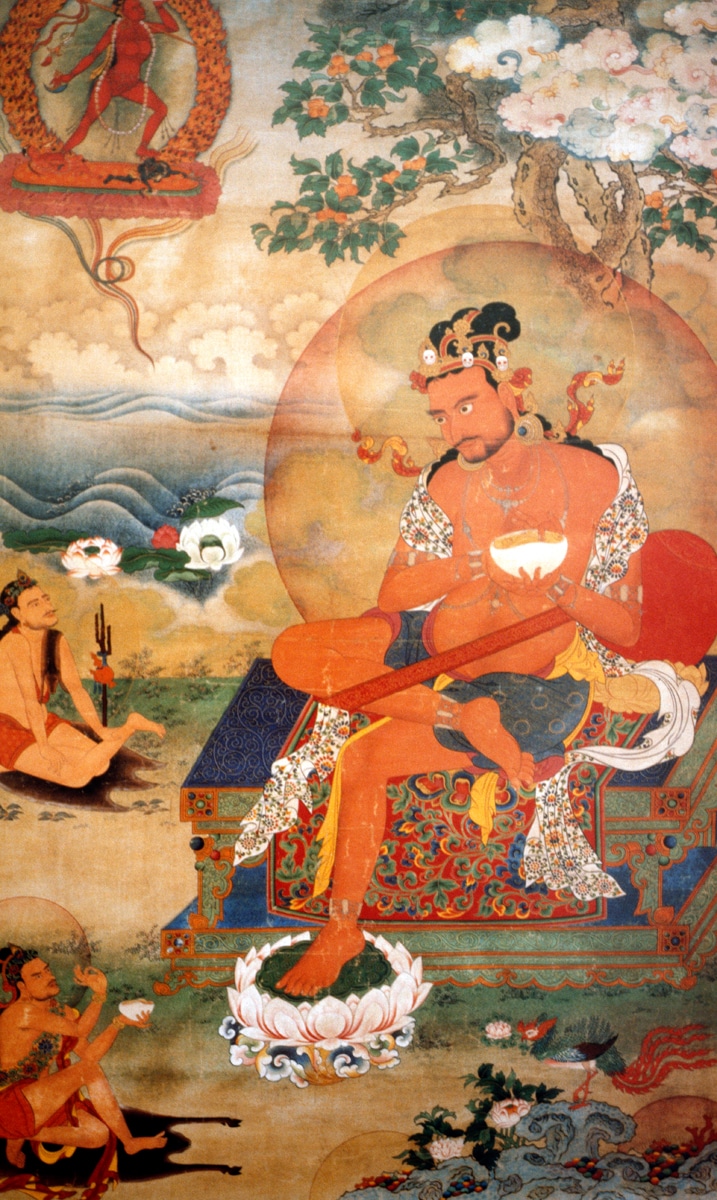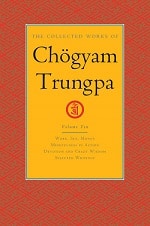
For further information about Ngedon School, read this excerpt from the introduction to Volume Ten.
We are inaugurating a new program at Naropa Institute, which will be called the Ngedön School. The establishment of this program is extremely important and powerful. It is modeled on the schools of the Kagyü tradition that have studied and achieved the intrinsic understanding of the buddhadharma. In the Kagyü tradition, the Ngedön school attained and understood the best of the Buddha’s teaching. Therefore, we take great pride in it. Introducing the Ngedön tradition in this part of the world, to you as students, will help tremendously.
Ngedön is a shortened form of ngepi-ton. Ngepa means “certain” and “real”; ton means “further essence.” So ngepi-ton means “understanding and comprehending fully what Buddha actually meant when he taught the dharma.”
Ngedön can be contrasted with the notion of trangdön. Trang means “straightforward”; dön means “meaning,” or “essence,” as before. We could say that the Buddha first taught us the pointing finger, so to speak, which is trangdön, and after that he taught the reality that the finger is pointing to, which is ngedön. For example, a parent might point to the moon and say to the child, “That is the moon,” and the child might think the finger itself is the moon [laughter]. Later on, the child will see that the finger is pointing to something else, which is actually the white disk of the moon itself.
Similarly, trangdön is the early stage in one’s understanding. First one has to realize and understand the metaphors and the connections at the trangdön level, and then at the ngedön level one asks, “Metaphors for what? With what? What is metaphoring?” There is an analogy for this in the Vajrayogini practice; if you are completely fascinated by the visualization alone, then you are fascinated by the finger. If you look for what Vajrayogini stands for, what the finger is pointing to, then you begin to understand.
Similarly, with banners, for instance, they are not just purely ink printed on satin; but they mean something. What the printing means is more important than the satin or ink itself. Of course, you understand that. What I am saying is that you should understand the purpose and the object of the purpose. You will understand more and more.
In the vajrayana tradition, we have what is known as the wisdom of example, and we have the wisdom itself. Similarly, we could say that the trangdön, the straightforward interpretation, or the teaching itself, is simply the wisdom of example. And the ngedön is the wisdom itself, what is exemplified by the trangdön. It is the same as in the analogy of the finger and the moon.
Some traditions talk about one hundred bowls of water each reflecting the one moon in the sky. Either you could say there are a hundred moons, one in each bowl (trangdön), or else you could say there is one more moon (ngedön), which is reflecting into the hundred bowls.
So trangdön is the reflection of the example, and ngedön is the reality that is reflected in the minds of ourselves. Do you understand? Trangdön is like a photograph, which is a facsimile of a person, and ngedön is the real person beyond the facsimile. So, without wasting too much time, we would like to study the reality; we would like to study the person, rather than the photograph of the person. That is what we are aiming at: enlightenment. We could aim for the facsimile of enlightenment, or for enlightenment itself. This is what we are trying to understand, what we are trying to talk about. Shall we have a discussion on this? You are more than welcome.
Question: Sir, when we talk about ngedön, are we talking about different teachings? Are some teachings trangdön teachings and other teachings ngedön? Is it correct to understand it that way?
Chögyam Trungpa Rinpoche: We are talking about the style of teaching, rather than the teachings themselves. When you take a photograph of a person, you don’t change the look of the person. It is just a photograph; the real person is three-dimensional and moves and speaks. We are talking about methodology in this case.
Q: So the style of ngedön actually puts us in touch with the real person?
CTR: It is a question of reality, yes, reality, much more so. That is why many people are shy of this approach. They don’t want to get too close. They pull back; they appreciate the facsimile rather than the reality.
Q: You have in the past mentioned that the Uttara Tantra (Tib. Gyü Lama) is an important text from our tradition.* Would that be ngedön?
CTR: I think so, yes.
Q: Is it ngedön because it speaks in such a way, or in such a style, that actually opens up the real reality?
CTR: Yes. That approach is connected with Marpa’s third journey to India: he had to see the reality, rather than the reflection.** He learned a lot from that—and we shouldn’t put down trangdön as being bad, particularly. It’s a great introduction, but when you have an introduction, you haven’t met the real person yet; you have just had an introduction. After the introduction, then, having met the real person, you get to know them.
Q: Sir, you said ngedön is what is reflected in the minds of ourselves. Could you say more about that?
CTR: Ngedön is what is actually in our mind, such as tathagatagarbha, sugatagarbha, buddha nature—and enlightenment itself.
Q: So it’s reflected in the sense of a clear, clean mirror, when there is no karma—
CTR: It is not even a mirror; it is looking at the person himself, three dimensionally.
Q: Sir, with due respect, may I ask you what teachings have you been giving us? If this is ngedön, beginning now, in this school, with your presence and your words, what have we received in the past? Has it been ngedön?
CTR: It is ngedön depending on how you receive it, rather than depending on what has been told. Now that you are worthy enough, we are telling you very boldly. Hopefully, you can take it. It is a very bold approach we are taking now. So far, we have been kind to you, so you wouldn’t get shocked. So far, we have been gentle to you. Now we are telling you the truth itself, which is very shocking, absolutely shocking. I was shocked when I was thirteen years old. Reality is very unpleasant sometimes, but if you get into reality properly, thoroughly, then it is blissful. And it is pleasant. This is so because reality speaks genuineness.
If somebody told you that you are ugly, you would be shocked, but that might be true. I’m not personally referring to you [laughter]. If somebody said that your ears are like a donkey’s, you would go . . . [Takes a deep breath] first. Then you might look at yourself in a mirror and feel your ears [laughter]. You might actually find your ears are like a donkey’s. It’s the truth, going further and further, which shocks us, and delights us at the same time.
Q: Sir, in the Ngedön School we’ll be starting with the vinayas and sutra literature, and then the abhidharma, and particular texts. Is the ngedön aspect how we relate to all of them, rather than the particular topics themselves? So it isn’t the teachings themselves, but how we approach them, that makes it ngedön?
CTR: It is how we approach them that makes it ngedön.
Q: So, in that sense, could we say that the teaching of the three marks of existence is ngedön?
CTR: It is ngedön, yes. And we will study the vinaya teachings, the rules and the discipline, and how we relate with that, from the ngedön point of view.
Q: So even though we might have studied some of these topics before, we could approach them differently in how we apply them?
CTR: Yes, it is how we apply the truth and the ultimate truth.
Q: And this cuts across any division of the teachings into hinayana, mahayana, and vajrayana?
CTR: There is no division. There is no division. It is how we look at it. A child might look at a diamond, a teenager might look at a diamond, and a grown-up person might look at a diamond: same diamond, same reality. But the discovery is different. It is a question of the perceiver rather than the perception itself. You find ngedön in the hinayana, and ngedön in the mahayana, and ngedön in the vajrayana.
Q: Sir, what is the role of study, in the examination of the diamond? Could we discover ngedön entirely in our practice, without studying texts, or is it important to study in order to go deeper?
CTR: I think it is very much connected with study, yes. Study has two parts: the study of the conventional truths and the study of real truth. In the Ngedön School we study the real truth, rather than the conventional truth.
Q: So study in the Ngedön School is somewhat different from our previous study?
CTR: It is not just intellectual study, but it is taking the teachings to heart. It is as if you were putting your finger on the sun, and burning your finger, and realizing the sun is hot. Then you will know more about the sun. This whole thing is the study of reality. For example in the vinaya, we study why we would kill somebody, why we would steal, why we have sexual intercourse with somebody, why we drink alcohol. That seems to be the point: why we do certain things. That will be the first study of hinayana from the ngedön point of view.
Then we will study why we hate somebody, why we dislike somebody, why we are unable to extend our compassion, our lovingkindness, to somebody. That would be the ngedön point of view of mahayana, which we have to study. We shouldn’t be shy. We should be forthright. Ngedön also means forthright, not being shy. Ngedön means that we are not hiding anything behind our frown or our smile. Genuine is the word: ngedön. Nge means “real,” ton means “subject,” so ngedön means “real subject.” Reality comes through—if you are open to it.
Q: Sir, you mentioned the quality of shyness or hesitancy. Now it is more a feeling of dealing with reality by putting your finger on the sun, and being burned, to find out exactly what the sun is like. Would you give some guidance as to how to work with our own hesitation as we approach the deeper level?
CTR: Yes. Well, you see, there is no “how.” It is up to you to discover the path. As we know, children walk in puddles. Their shoes get wet and cold, and they come back to their mothers, or parents, and they cry. Some parents will spank them, and some parents will change their shoes, their socks. It’s a question of discovery. The path is yours. That’s why dharma is put in between sangha and Buddha. You have Buddha, dharma, and sangha. Why is dharma in the middle? It is up to you. And this particular school, ngedön, is obviously geared to that. We present the Buddha and the early schools of Buddhism, and we also present to you the teachers of ngedön thought, the ngedön lineage, altogether. And we leave a little gap for you to discover the path, the dharma, itself. It’s up to you, sweetheart.
Q: Thank you, sir.
Q: Sir, could you tell us what happened to you at thirteen years old that was shocking to you?
CTR: I was just shocked. I thought they had laid out the whole journey for me, and when I realized they hadn’t, there was a big gap, a Black Hole of Calcutta [laughter]. I was shocked and realized that I had to do it myself. And at the same time, I was quite pleased that they didn’t hassle me. Things were left up to me to do. So it is pain and pleasure at the same time.
Q: Thank you, sir.
CTR: So, please study. The basic meaning of study here is that you are not fooling yourself. You are not pretending to understand. At the same time, there is joy in study; you don’t have to pull long faces. It is wonderful to study. It’s different than going to a Protestant school or a Hebrew school. You are not condemned. You are cheered; you are brought up. The more you study, the more you find delight in the whole thing. So please, cheer up.
If I were a schoolmaster, I wouldn’t just smile at my students; I would push them. So please smile and enjoy. This is the most enjoyable thing that you could discover: learning about yourself and learning about the world—learning how you can actually walk on the path. So please have a cheerful time, and please don’t drop out. I want you all to raise your hands to say that you are not going to drop out. Good. Thank you very much.
From The Collected Works of Chögyam Trungpa, Volume Ten © 2017 by Diana J. Mukpo. Introduction to Volume Nine © 2017 by Carolyn Rose Gimian. Reprinted in arrangement with Shambhala Publications, Inc. Boulder, CO. www.shambhala.com
* The Uttara Tantra (Tib. Gyü Lama) is one of the five treatises of Maitreya, a commentary on the teachings of the third turning of the wheel of dharma explaining buddha nature. It is included among the texts that form the core of the curriculum in most shedras, or monastic colleges.
** Marpa the Translator, the first Tibetan holder of the Kagyü lineage, traveled to India three times to receive teachings from Naropa, his root guru, and other great Buddhist teachers. On the third visit, after spending months trying to find Naropa, Marpa was finally reunited with him. While they were together, Naropa manifested a tantric mandala in the sky and asked Marpa if he would prostrate to the mandala or to his teacher. Marpa prostrated to this miraculous manifestation, the mandala, and Naropa then told him that the mandala only arose because of Naropa and that the guru was the source of all mandalas and teachings. Then the mandala dissolved into Naropa’s heart center. This is probably the incident, quite well known, that Trungpa Rinpoche is referring to here. See also “An Element of Unreasonability,” Vol. 10, p. 651.







